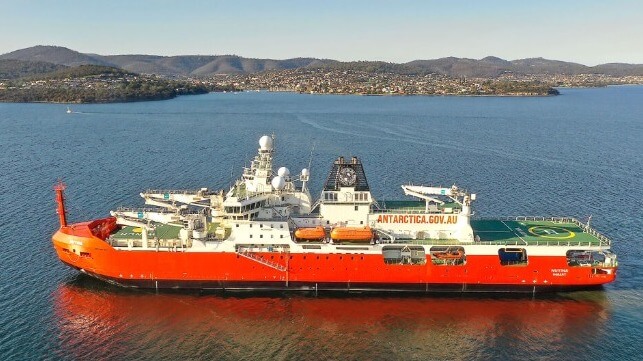Australian Research Vessel Maps New Subsea Canyon in Antarctic Storm

The Australian Antarctic Division (AAD) is celebrating the capabilities of its controversial new research ship RSV Nuyina after the discovery of a massive underwater canyon.
The icebreaker was on a normal resupply mission to the Casey research station when four-meter seas and 50-knot winds forced the operation to be put on hold. Rather than sit and wait for the weather to pass, the crew decided to use the time to map the seafloor at the nearby Adams Glacier, which is about 35 nautical miles away. The acoustics team had earlier spotted what might have been the tip of a canyon.
A total of 15 hours of mapping in front of Adams Glacier by a team of acousticians on board the icebreaker led to the discovery of a 2100 meter-deep, 9000 meter-wide canyon, extending more than 25 nautical miles off the glacier front.
The crew used the ship's multibeam echosounder to map the canyon, and the data may yield insights into the geological and glacial history of the area.
The Australian Antarctic Division called the discovery a testament to the $500 million ship's value. “One of the specific objectives in building RSV Nuyina was to provide Australia with the capability to map the Antarctic continental shelf. Discovery and mapping of these deep glacial canyons is key to developing better models of the interaction between the Antarctic ice sheet and the ocean. This is just the beginning,” said Lloyd Symons, RSV Nuyina technology manager.
????After 31 days and a journey of 7000 km, RSV Nuyina has returned from a successful #Antarctic resupply voyage that included the discovery of a deep underwater canyon off Adams Glacier.???? https://t.co/CLhtkTScSW pic.twitter.com/kYcpHgDJgw
— antarctica.gov.au (@AusAntarctic) January 15, 2024
This was the second time AAD scientists had discovered an Antarctic seafloor feature using the ship’s acoustic instruments. Two years ago, on Nuyina’s maiden voyage to Casey, scientists mapped the nearby Vanderford Canyon, which is 2200 meters deep, 2000 meters wide and about 25 nautical miles long.
“Nuyina’s multibeam echosounder gives us much greater capability for detailed mapping of the seafloor than we’ve ever had before, and these two new discoveries suggest there will be many more to come,” said Alison Herbert, AAD senior acoustician.
